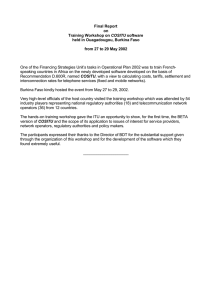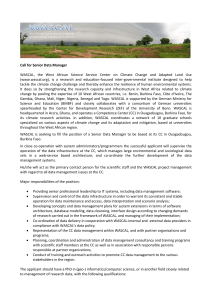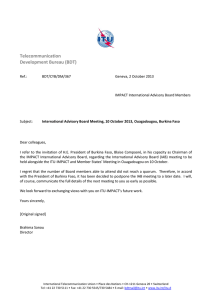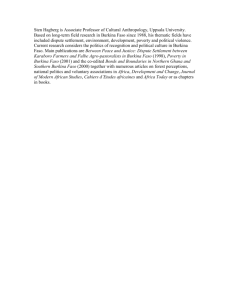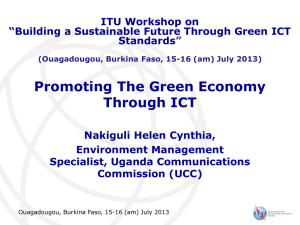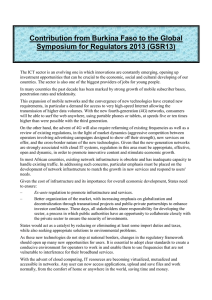British Journal of Dairy Sciences 2(1): 11-17, 2011 ISSN: 2044-2440
advertisement
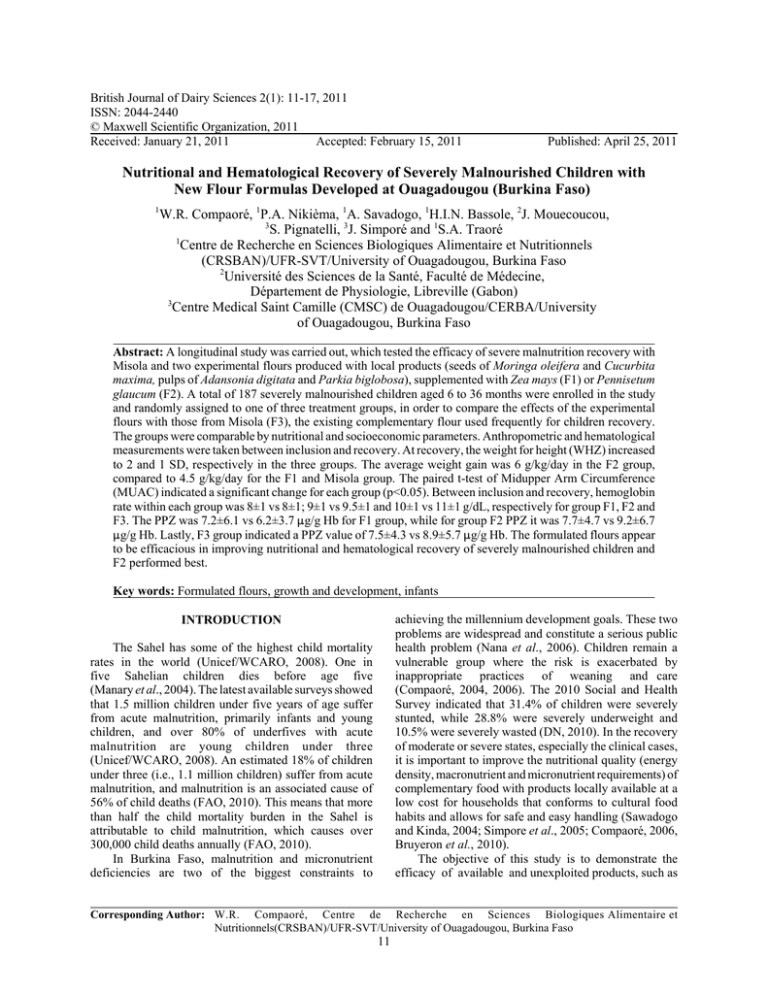
British Journal of Dairy Sciences 2(1): 11-17, 2011 ISSN: 2044-2440 © Maxwell Scientific Organization, 2011 Received: January 21, 2011 Accepted: February 15, 2011 Published: April 25, 2011 Nutritional and Hematological Recovery of Severely Malnourished Children with New Flour Formulas Developed at Ouagadougou (Burkina Faso) 1 W.R. Compaoré, 1P.A. Nikièma, 1A. Savadogo, 1H.I.N. Bassole, 2J. Mouecoucou, 3 S. Pignatelli, 3J. Simporé and 1S.A. Traoré 1 Centre de Recherche en Sciences Biologiques Alimentaire et Nutritionnels (CRSBAN)/UFR-SVT/University of Ouagadougou, Burkina Faso 2 Université des Sciences de la Santé, Faculté de Médecine, Département de Physiologie, Libreville (Gabon) 3 Centre Medical Saint Camille (CMSC) de Ouagadougou/CERBA/University of Ouagadougou, Burkina Faso Abstract: A longitudinal study was carried out, which tested the efficacy of severe malnutrition recovery with Misola and two experimental flours produced with local products (seeds of Moringa oleifera and Cucurbita maxima, pulps of Adansonia digitata and Parkia biglobosa), supplemented with Zea mays (F1) or Pennisetum glaucum (F2). A total of 187 severely malnourished children aged 6 to 36 months were enrolled in the study and randomly assigned to one of three treatment groups, in order to compare the effects of the experimental flours with those from Misola (F3), the existing complementary flour used frequently for children recovery. The groups were comparable by nutritional and socioeconomic parameters. Anthropometric and hematological measurements were taken between inclusion and recovery. At recovery, the weight for height (WHZ) increased to 2 and 1 SD, respectively in the three groups. The average weight gain was 6 g/kg/day in the F2 group, compared to 4.5 g/kg/day for the F1 and Misola group. The paired t-test of Midupper Arm Circumference (MUAC) indicated a significant change for each group (p<0.05). Between inclusion and recovery, hemoglobin rate within each group was 8±1 vs 8±1; 9±1 vs 9.5±1 and 10±1 vs 11±1 g/dL, respectively for group F1, F2 and F3. The PPZ was 7.2±6.1 vs 6.2±3.7 :g/g Hb for F1 group, while for group F2 PPZ it was 7.7±4.7 vs 9.2±6.7 :g/g Hb. Lastly, F3 group indicated a PPZ value of 7.5±4.3 vs 8.9±5.7 :g/g Hb. The formulated flours appear to be efficacious in improving nutritional and hematological recovery of severely malnourished children and F2 performed best. Key words: Formulated flours, growth and development, infants achieving the millennium development goals. These two problems are widespread and constitute a serious public health problem (Nana et al., 2006). Children remain a vulnerable group where the risk is exacerbated by inappropriate practices of weaning and care (Compaoré, 2004, 2006). The 2010 Social and Health Survey indicated that 31.4% of children were severely stunted, while 28.8% were severely underweight and 10.5% were severely wasted (DN, 2010). In the recovery of moderate or severe states, especially the clinical cases, it is important to improve the nutritional quality (energy density, macronutrient and micronutrient requirements) of complementary food with products locally available at a low cost for households that conforms to cultural food habits and allows for safe and easy handling (Sawadogo and Kinda, 2004; Simpore et al., 2005; Compaoré, 2006, Bruyeron et al., 2010). The objective of this study is to demonstrate the efficacy of available and unexploited products, such as INTRODUCTION The Sahel has some of the highest child mortality rates in the world (Unicef/WCARO, 2008). One in five Sahelian children dies before age five (Manary et al., 2004). The latest available surveys showed that 1.5 million children under five years of age suffer from acute malnutrition, primarily infants and young children, and over 80% of underfives with acute malnutrition are young children under three (Unicef/WCARO, 2008). An estimated 18% of children under three (i.e., 1.1 million children) suffer from acute malnutrition, and malnutrition is an associated cause of 56% of child deaths (FAO, 2010). This means that more than half the child mortality burden in the Sahel is attributable to child malnutrition, which causes over 300,000 child deaths annually (FAO, 2010). In Burkina Faso, malnutrition and micronutrient deficiencies are two of the biggest constraints to Corresponding Author: W.R. Compaoré, Centre de Recherche en Sciences Biologiques Alimentaire et Nutritionnels(CRSBAN)/UFR-SVT/University of Ouagadougou, Burkina Faso 11 Br. J. Dairy Sci., 2(1): 11-17, 2011 until recovery. Children were systematically allocated to one of three dietary regimens: blend maize flour (F1), blend millet flour (F2), and Misola (F3) (the usually complementary flour). Children were followed daily and they completed the study when they reached WHZ>0, relapsed or died. Upon resolution of complications and return of appetite, children were eligible for the homebased therapy study. Children who had not been hospitalized with malnutrition were eligible if they were referred from the outpatient department for treatment of malnutrition with either oedema or a weight-for-height (WHZ) Z score <-3. The mothers of the participants gave their informed consent. Upon patient enrollment, information about the history of illness, family demographics, and socioeconomic status was acquired in an interview with the children’s mother, and the inpatient hospital chart in order to determine their nutritional and illness status (presence of oedema, cough, mycosis or diarrhea). seeds of Moringa oleifera and Cucurbita maxima and pulps of Adansonia digitata and Parkia biglobosa, supplemented with Zea mays (F1) or Penniseum glaucum (F2), to improve the nutritional and hematological status of the children suffering from severe malnutrition compared to Misola (F3), the existing complementary flour, develop in 1997 and used frequently for child recovery (Laurent, 1995). MATERIALS AND METHODS The study was designed in three steps: flours formulation, flours analysis and production and the intervention step (the recovery study). Formulated flours: Formula 1 (F1) consists of the following products: Zea mays, seeds of Cucurbita maxima and Moringa oleifera, pulps of Parkia biglobosa, Adansonia digitata and sugar: 60:20:10:3:3:4% (w/w); Formula 2 (F2): Pennisetum glaucum, seeds of Cucurbita maxima and Moringa oleifera, pulps of Parkia biglobosa, Adansonia digitata and sugar: 60:22:10:4:2:2% (w/w); Misola formula (F3), the existing complementary flour: Pennisetum glaucum, Soja hispida, Arachis hypogeae and sugar 60:20:10:10 (w/w). The nutritional composition of these three formulae was determined in a precedent study (Compaoré et al., 2011). Anthropometric measurements: Weight was measured with an electronic scale (Seca 881, max. 200 kg; CFAO, Sèvres-France) to the nearest 100 g. Infants and children less than two years were weighed using a spring balance to the nearest 10 g. Height was taken on bare feet; for infants and for children less than two years, recumbent length was measured using a wooden measuring board to the nearest 0.1 cm. Age was taken using official or health care documents, while midupper arm circumference (MUAC) was measured with ribbon method described by Shakir and Morley (1974). Site of study: This study was conducted from June to December 2010 at rehabilitation unit of Centre Médical Saint Camille of Ouagadougou for nutritional recovery and at Biological, Food and Nutritional Research Centre (CRSBAN), at University of Ouagadougou (Burkina Faso) for data analysis and interpretation. Determination of HIV status: HIV status was determined using an Enzyme Linked Immunoabsorbent Assay (ELISA) (Vironostika HIV, Organon Teknika, Durham, NC); equivocal and positive tests were confirmed using a second test. The recovery study: The study protocol has been approved by the Ethical committee. The rehabilitation unit of Centre Medical Saint Camille (CMSC) of Ouagadougou (Burkina Faso), a daily outpatient management center where all complicated cases are referred to the hospital. During the presence of children in rehabilitation unit, they received therapeutic food F75 and F100 (skim milk, oil, sugar) containing respectively 75 Kcal/100 mL and 100 Kcal/100 mL (WHO, 1999), and in the afternoon they go back at home. To avoid therapeutic food contamination, none of malnourished children can bring it home (Diop et al., 2003) and the mortality risk due to hypoglycemia conduced the nurses to give blended flour to the children’s mothers for preparation at home. The recovery study was a longitudinal study which consisted of 187 children aged 6 to 36 months. All children discharged from the Nutritional Rehabilitation Unit between 01 June to 30 September 2010 at the Centre Médical Saint Camille of Ouagadougou, and negative to HIV test were eligible for this study and were follow up Hematological measurements: Hemoglobin (Hb), Hematocrit (Ht) and red cell protoporpyrin (PPZ) were used to define and treat anemia associated with malnutrition and were taken at inclusion and after recovery. Hematological measurements were taken according to method describe by Dossou et al. (2003). The Hb was measured with Hemocue kit (HemoCue® AB, Ängelholm, Sweden), while hematocrit was determined by micro centrifugation (Compurelectronic GMBH, Munich, Germany) and the PPZ by hematofluorimetry using a ProtoFluor-Z kit (HelenaFrance Labs, Saint-Leu-la-Fôret, France ). Statistical analysis: Epi info 2002 (version 1.1.2, Centers for Disease Control, Atlanta, GA, U.S.A.), which uses the World Health Organization’s NCHS reference population, and Stata software were used to establish WHZ score as indices of nutritional status. Data were finally exported 12 Br. J. Dairy Sci., 2(1): 11-17, 2011 Table 1: Baseline characteristics of children Children characteristics Males Females Age (months) Weight-for-height, Zscore MUAC (cm) Marasmus Kwashiorkor (%) Cough (%) Fever (%) Vomiting (%) Diarrhoea (%) Anorexia (%) Cold mycosis Group 1 (F1) N = 52 25 (48.08%) 27 (51.92%) 6-36 -3±1SD 10.78±1.12 33 (63.46%) 19 (36.54%) 18 (34.61%) 32 (51.54%) 10 (19.23%) 22 (42.31%) 23 (44.23%) 8 (15.38%) 7 (13.46%) Group 2 (F2) N = 70 29 (41.43%) 41 (58.57%) 6-36 -3±1 SD 10.86±0.93 68 (97.14%) 2 (2.86%) 24 (34.28%) 42 (60.00%) 21 (30.00%) 37 (52.86%) 47 (67.14%) 11 (15.71%) 19 (27.14%) into SPSS 13.0 for further statistical analyses. Descriptive statistics were used to explore the data and describe central tendencies. Pearson correlation was used to explore association between continuous variables, while for categorical variables Student t-test was used. Finally, multiple linear regression analyses were used to describe the nature of associations between dependant variables, and model the rate of weight gain with respect to fever, cough, and diarrhoea. A probability of p<0.05 was considered to be statistically significant. The outcomes for the three dietary groups were compared by a time-event analysis (Kaplan-Meier), which allowed for the inclusion of information from all children while they participated, as well as intention to treat analysis. The differences in weight gain, duration of recovery, hematologic parameters, and the growth in MUAC between the three dietary groups were determined with 95% confidence intervals. 10 Inclusion Group 3 (F3) N = 65 25 (38.46%) 40 (61.54%) 6-36 -3±1 SD 10.74±0.94 51 (78.46) 14 (21.54%) 13 (20.00%) 43 (66.15%) 9 (13.84% ) 50 (76.92%) 34 (52.31%) 4 (6.15%) 27 (41.54%) Recovery 9 8 Weight (kg) 7 6 5 4 3 2 1 0 Group 1 Group 2 Group 3 Fig. 1: Evolution of weight of children during the recovery study necessary to reach a weight gain of 7 to 15 g/kg body weight/day (Spady et al., 1976; Khanum et al., 1994). There are several explanations for this situation: the first is associated with food consumed at home, which could not be measured directly, but was obtained by a questionnaire managed with the mother. So, it was unclear that experimental flour was preferentially given to children at home (Manary et al., 2004). The second reason is associated with energetic value of prepared porridges which could be improved by addition of red sorghum amylase. But in spite of this amylase being added to experimental flours, mothers did not use it. Lastly, difficulties related to wood resources to prepare experimental porridges have been evocated by mothers and constitute a limiting factor. The recall method to determine morbidity status of children was not validated, and the correlation between growth and morbidity parameters is not statistically significant. The morbidity parameters have an effect on weight evolution (Diop, 2005). So, food and care practices of mother need to be studied in order to help the mother be more effective during malnutrition management (Diop, 2005). RESULTS AND DISCUSSION There were no differences in the baseline demographic or nutritional characteristics between the children that received F1, F2 and F3 (Table 1). There were no differences in primary or secondary outcome parameters when boys were compared to girls, so outcomes were not stratified by sex. Evolution of weight: There was an evolution in weight between the inclusion and recovery (Fig. 1). The weight gain was around 4.5±1.8 g/kg body weight/day for group 1, while for group 2 it was 6±2 g/kg body weight/day. Lastly the weight gain for group 3 was 4±1.2 g/Kg/body weight/day. The comparison of weight gain between these three groups was statistically significant (p = 0.04) (Fig. 2). The weight gain is lower than the recommended value which varies from 10 to 20 g/kg of body weight/day (Ashworth and Millward, 1986). The weak weight gain could affect growth parameters (Fjeld et al., 1989), however, studies showed that the home based therapy could be effective if all conditions are 13 Br. J. Dairy Sci., 2(1): 11-17, 2011 6 14 5 12 4 3 2 1 0 Inclusion Recovery 10 MAUC (cm) weight (g/kg/day) 7 Group 1 Group 2 8 6 4 Group 3 2 Fig. 2: Weight gain of children during the recovery study 74 Inclusion 0 Recovery Group 1 Group 2 Group 3 73 Fig. 4: Evolution of MUAC heigh (cm) 72 infections on child growth has been defined for many years (Scrimshaw et al., 1968; Lopez de Romana et al., 1989; Rowland et al., 1997); and these morbidity parameters are: anorexia (p = 0.032), diarrhea (p = 0.000), cough (p = 0.027), and mycosis (p = 0.003). The effect of these morbidity parameters (illness) on weight gain was calculated by regressing weight gain against number of days ill. Anorexia reduces the food intake and diarrhea and cough reduce weight gain (Motarjemi et al., 1993; Manary et al., 2004), but the role of mycosis remains to be determined. Diarrhea produced a deficit in weight gain of 32 g per day ill, and cough/cold a deficit of 16.4 g per day ill. From these data the overall impact of illness on weight gain was calculated and in the average child between 12 and 24 months diarrhea reduced growth by 160 g and cough/cold by 95 g. Hardly any of the studies examining poor growth as a risk factor for morbidity contained information on social or environmental variables (Tielsch et al., 2008). An increase in duration of illness might be a reflection of the less than satisfactory feeding patterns during illness that sometimes occurs in poorer families (Layte et al., 2005). Similarly, poorer families may have less opportunity to obtain access to health services or purchase medicines, and so illnesses may last longer. Effects of nutritional status on incidence of diarrheal episodes, is more determined by environment and personal hygiene, so it is important to minimize the infant’s exposure to diarrheal pathogens, which are common in other foods and in water (Sheth and Dwivedi, 2006). Thus, poor growth may be a proxy indicator for poor social, economic and environmental background. Respiratory infections have also been implicated in growth faltering, and anorexia, fever, pain, vomiting (especially in pertussis) and associated diarrhea, may all be important contributory factors (Tomkins and Watson, 1993). 71 70 69 68 67 Group 1 Group 2 Group 3 Fig. 3: Evolution of height of children during the recovery study Evolution of height: Evolution of height was similar between the three groups of nutritional recovery, and so, the difference was not statistically significant (Fig. 3). The notion that diets which are entirely plant based may lack components needed for optimal growth is supported by work done in Kenya (Neumann et al., 2002). The energy density of these experimental flours is higher than to maize/soy food, and many cereal-legume combinations that are often advocated as healthy foods for undernourished children in the developing world (Manary et al., 2004). Evolution of MUAC and WHZ: The MUAC was the most sensitive parameter and its change is presented in Fig. 4. Comparison of the MUAC value within each group revealed a significant difference for Group 1 (r = 0.513; p = 0.000), Group 2 (r = 0.538; p = 0.000) and Misola (r = 0.202; p = 0.107). Comparison between three groups by the time-event analysis (Kaplan-Meier) revealed a better efficacy of recovery for Group 2 than Groups 1 and 3 (p = 0.046). This situation can be explained by the physico chemical composition and energetic content of F2, which has more Lipids, carbohydrates than F1 and Misola (Compaoré et al., 2011). Morbidity and growth: Analysis by linear regression showed that many parameters of morbidity had an influence on the statural growth of children. The role of Duration of recovery: The duration of study is showed at Fig. 5. This long period of recovery can be explained 14 Br. J. Dairy Sci., 2(1): 11-17, 2011 Duration(days) Table 2: Evolution of hematologic parameters Parameters N Hb (g/dl) 1 (n = 52) 2 (n = 70) 3 (n = 65) Ht rates (%) 1 (n = 52) 2 (n = 70) 3 (n = 65) PPZ (:g/g Hb) 1 (n = 52) 2 (n = 70) 3 (n = 65) Values are means ± SD (n = 3); *: p<0.05 Inclusion 8±1 9±1 10±1 24± 3 26±3 25±2 7.2±6.1 7.7±4.7 7.5±4.3 Recovery 8±1 9±1 11±1 26±3 26±3 27±2 6.2±3.7 9.2±6.7 8.9±5.7 p-value 0.535 0.402 0.011* 0.345 0.202 0.023* 0.206 0.042* 0.044* respectively for Hb and Ht) between inclusion and recovery (Table 2). A negative correlation between weight gain and Hb variation was found (r = -0.371; p = 0.016) and could be explained by low contribution of bioavailable iron during nutritional recovery due to synthesis of cells and red cells (Diop et al., 2003). 100 90 80 70 60 50 40 30 20 CONCLUSION 10 0 The formulated flours appear to be efficient in improving nutritional and haematological recovery of children suffering from severe malnutrition, and F2, a mixture of Pennisetum glaucum, seeds of Cucurbita maxima and Moringa oleifera, pulps of Parkia biglobosa and Adansonia digitata, performed best. Nutritional supplementation studies have generally shown that improved growth is very difficult to achieve. Where supplementation has been followed by reduction in morbidity it is difficult to know if it was the result of nutritional change or attention to improved environment, education and health care. It seems clear that the only effective way to improve growth is to reduce the burden of infection at the same time as improving dietary intake. This study showed that home based therapy for uncomplicated severely malnourished children has been successful in West Africa and could offer a better alternative in Burkina Faso, and contribute to food diversification and valorization of locals products. Group 1 Group 2 Group 3 Fig. 5: Duration of total recovery by high dilution of prepared flours at home, which contain low energy (Traoré, 2005). It also suggests that there is sharing of the experimental flours at home with other family members. Even though ample experimental flour of each sample was provided to mothers, it may have not been prepared due to the additional time and resources needed to prepare 6 feedings per day in a African setting where cooking is done outside over a wood fire. Evolution of hematologic parameters and growth: At inclusion the Hb and Ht rates of children were low, but, PPZ value was high, probably due to ferriprive anemia (Table 2). The PPZ is a good indicator of iron deficiency in children (Mei et al., 2003), but the interpretation of these results must be completed by analysis of other parameters of martial deficiency, like serum ferritin, transferrine and protein of the inflammatory phase. The Iron supplementation during nutritional recovery improves the Hb rate significantly but this variation was determined by weight gain, because high weight gain is not favorable to significant Hb evolution (Macdougall et al., 1982; Michaelsen et al., 1995; Wharf et al., 1997; Georgieff et al., 2002; Thorsdottir et al., 2003). So, the weak evolution of Hb and Ht in Groups 1 and 2 can be explained by this situation, because F1 and F2 have the better weight gain compared to F3, which has the lower weight gain. This lower weight gain can explained by the better evolution of Hb and Ht in Group 3 which is significant (10±1 vs 11±1 g/dL; p = 0.011 and 25±2 vs 27±2%, p = 0.023 ACKNOWLEDGMENT The authors acknowledge Professors Jacques Simporé (CMSC/CERBA/UO) and Nicolas Barro (CRSBAN/UFR-SVT/UO), the CMSC of Ouagadougou (Burkina Faso), and all workers of CREN for providing facilities for this work. Particular thanks to head managers, Fathers Salvatore Pignatelli, Guy Flavien Ouédraogo, and Jean de Dieu Belembaongo and Sisters Thérèse Yoda and Félicité Bougma. Thanks to Molley O’Keefe from Middlebury College, Vermont (United States of America) for her technical support. The financial support from ISP/IPICS (Sweden) and the project PACER-Union Economique et Monétaire Ouest Africaine (PACER/UEMOA) were also appreciated. 15 Br. J. Dairy Sci., 2(1): 11-17, 2011 REFERENCES Laurent, F., 1995. The Misola flour, Creation and operation of the artisanal production units and the groups of community manufacture. Files of Misola Association, pp: 7-30. Layte, R., A. Nolan, B. Nolan and T. Van Ourti, 2005. Health and morbidity by age and socioeconomic characteristics. ENEPRI Res. Rep., 15: 124. Lopez de Romana, G., K.H. Brown, R.E. Black and H.C. Kanashiro, 1989. Longitudinal studies of infectious diseases and physical growth of infants in Huascar, an underpriviliged peri-urban community in Lima, Peru. Am. J. Clin. Epidemiol., 129: 769-784. Macdougall, L.G., G. Moodley, C. Eyberg and M. Quirk, 1982. Mechanisms of anemia in protein-energy malnutrition in Johannesburg. Am. J. Clin. Nutr., 35: 229-235. Manary, M.J., M.J. Ndekha, P. Ashorn, K. Maleka and A. Briend, 2004. Home based therapy for severe malnutrition with ready-to-use food. Arch. Dis. Child, 89: 557-561. Mei, Z., I. Parvanta, M.E. Cogswell, E.W. Gunter and L.M. Grummer-Strawn, 2003. Erythrocyte protoporphyrin or hemoglobin: Which is a better screening test for iron deficiency in children and women? Am. J. Clin. Nutr., 77: 1229-1233. Michaelsen, K.F., N. Milman and G. Samuelson, 1995. A longitudinal study of iron status in healthy Danish infants: Effects of early iron status, growth velocity and dietary factors. Acta Paediatr., 84: 1035-1044. Motarjemi, Y., F. Kaferstein, G. Moy and F. Quevedo, 1993. Contaminated weaning food: A major risk factor for diarrhoea and associated malnutrition. Bull. WHO, 71: 79-92. Nana, C.P., I. Brouwer, N.M. Zagre and A.S. Traore, 2006. Promotion of liver in the control of vitamin A deficiency (VAD) in rural Burkina Faso: Lessons learned and perspective. Third African Food Science and Nutrition Conference: Application of chemistry in food science and nutrition for improved food and nutrition security in Africa, pp: 40. Neumann, C.G., S. Whaley and M.D. Sigman, 2002. Animal source foods improve cognitive performance, activity and nutrition status in Kenyan school children. Pediatr. Res., 51: 192A. Rowland, M.D., S.G. Rowland and T.J. Cole, 1997. Impact on nutrition on the growth of children from 0 to 2 years in an urban West African community. Am. J. Clin. Nutr., 47: 134-135. Sawadogo, J.M. and J. Kinda, 2004. Role of the Misola flour in the prevention of malnutrition and the nutritional recovery of the children. Second international workshop: Food-based approaches for a healthy nutrition in West Africa: The role o food technologists and nutritionists, pp: 13. Scrimshaw, N.S., C.I. Taylor and J.E. Gordon, 1968. Interactions of Nutrition and Infection. World Health Organization, Geneva. Ashworth, A. and D.J. Millward, 1986. Catch-up growth in children. Nutr. Rev., 44: 157-163. Bruyeron, O., M. Denizeau, J. Berger and S. Trèche, 2010. Marketing complementary foods and supplements in Burkina Faso, madagascar, and vietnam: Lessons learned from the Nutridev program. Food Nutr. Bull., 31(2): S154-S167. Compaoré, W.R., 2004. Association of child care not based on food and the growth of children aged 1 to 5 years old in the Zondoma province (Burkina Faso). M.S.I Thesis, University of Ouagadougou, Burkina Faso, pp: 47. Compaoré, W.R., 2006. Efficacy of Spirulina and Misola in the nutritional, hematological and immune recovery of children suffering from severe malnutrition, admitted to the Saint Camille CREN in Ouagadougou. M.S.II Thesis, University of Ouagadougou, Burkina Faso, pp: 57. Compaoré, W.R., P.A. Nikièma, H.I.N. Bassolé, A. Savadogo, D.J. Houhouingan, J. Mouecoucou and A.S. Traoré, 2011. Nutritional properties of enriched local complementary flours. Adv. J. Food Sci. Technol., 3(1): 31-39. Diop, E.H.I., 2005. Management of severe malnutrition of the child: Uses of solid food (RTUF: Ready-to-usedtherapeutic-food) equivalent to F100 milk of WHO. Ph.D. Thesis, University Cheick Anta Diop, Dakar, Senegal, pp: 127. Diop, E.H.I., N.I. Dossou, M.M. Ndour, A. Briend and S. Wade, 2003. Comparison of the efficacy of a solid ready-to-use food and a liquid, milk-based diet for the rehabilitation of severely malnourished children: A randomized trial. Am. J. Clin. Nutr., 78: 302-307. DN, 2010. National nutritional investigation 2010. Final report, Health Ministry of Burkina Faso, pp: 45. Dossou, I.N., S. Wade, A.T. Guiro, C.S. Sarr, B. Diaham, D. Cissé, J.P. Beau, P. Chappuis, D. Hoffman and D. Lemonnier, 2003. Nutritional status of preschool Senegalese children: long-term effects of early severe malnutrition. Br. J. Nutr., 90: 1123-1132. FAO, 2010. State of Food Insecurity in the World 2010: Addressing Food Insecurity in Protracted Crises. 11th Edn., ISBN: 9789251066102, pp: 56. Fjeld, C.R., D.A. Schoeller and K.H. Brown, 1989. A new model for predicting energy requirements of children during catch-up growth, developed using doubly labeled water. Pediatr. Res., 25: 503-508. Georgieff, M.K., S.W. Wewerka, C.A. Nelson and R.A. Deregnier, 2002. Iron status at 9 months of infants with low iron stores at birth. J. Pediatr., 141: 405-409. Khanum, S., A. Ashworth and S.R.A. Huttly, 1994. Controlled trial of three approaches to the treatment of severe malnutrition. Lancet, 344: 1728-1732. 16 Br. J. Dairy Sci., 2(1): 11-17, 2011 Shakir, A. and D. Morley, 1974. Measuring malnutrition. Lancet, 7: 758-759. Sheth, M. and R. Dwivedi, 2006. Complementary foods associated diarrhea. Ind. J. Pediatrics, 73: 61-64. Simpore, J., F. Zongo, F. Kabore, D. Dansou, A. Bere, J.B. Nikiema, S. Pignatelli, D. M. Biondi, G. Ruberto and S. Musumeci, 2005. Nutrition rehabilitation of HIV-infected and HIV-negative undernourished children utilizing Spirulina. Ann. Nutr. Metab., 49(6): 373-380. Spady, D.W., P.R. Payne and D. Picou, 1976. Energy balance during recovery from malnutrition. Am. J. Clin. Nutr., 29: 1073-1088. Thorsdottir, I., B.S. Gunnarsson, H. Atladottir, K.F. Michaelsen and G. Palsson, 2003. Iron status at 12 months of age-effects of body size, growth and diet in a population with high birth weight. Eur. J. Clin. Nutr., 57: 505-513. Tielsch, J.M., L. Rahmathullah, J. Katz, R.D. Thulasiraj, C. Coles, S. Sheeladevi and K. Prakash, 2008. Maternal night blindness during pregnancy is associated with low birthweight, morbidity, and poor growth in South India. J. Nutr., 138(4): 787-792. Tomkins, A. and F. Watson, 1993. Malnutrition and infection-A review-Nutrition policy discussion. United Nations, Administrative Committee on Cordination/Subcommittee on Nutrition, 5: 16-35. Traoré, T., 2005. Development and evaluation of a strategy for the improvement of complementary food for young children in Burkina Faso, Ph.D. Thesis, University Ouagadougou, Burkina Faso. Unicef/WCARO, 2008. Malnutrition in the Sahel. Retrieved from: http//:www.unicef.org/wcaro/ 2819.html, (Accessed on: January 10, 2010). Wharf, S.G., T.E. Fox, S.J. Fairweather-Tait and J.D. Cook, 1997. Factors affecting iron stores in infants 4-18 months of age. Eur. J. Clin. Nutr., 51: 504-509. WHO, 1999. Management of Severe Malnutrition. A Manual for Physicians and other Senior Health Workers. World Health Organization, Geneva, pp: 72. AUTHOR’S CONTRIBUTION Nutritional recovery was taken at Centre Médical Saint Camille where Father Doctor Pignatelli is the director and medical treatment was rigorously followed by him. Father Professor Simporé is the director of CERBA and Centre Médical Saint Camille Laboratory where hematological analyses were taken and the ethical protocol was corrected and defined by him. Professor Mouecoucou reviewed this article and gave final interpretation for statistical analyses and results. Professor Traoré, the director of CRSBAN at University of Ouagadougou had original idea for this study and financial support for this study is passed by him. Doctor Nikièma corrected the final protocol for study and Doctors Savadogo and Bassole reviewed this article and help to correction. The daily management of children, study implementation, data collection and final interpretation and discussion were given by Doctor Compaoré. 17
